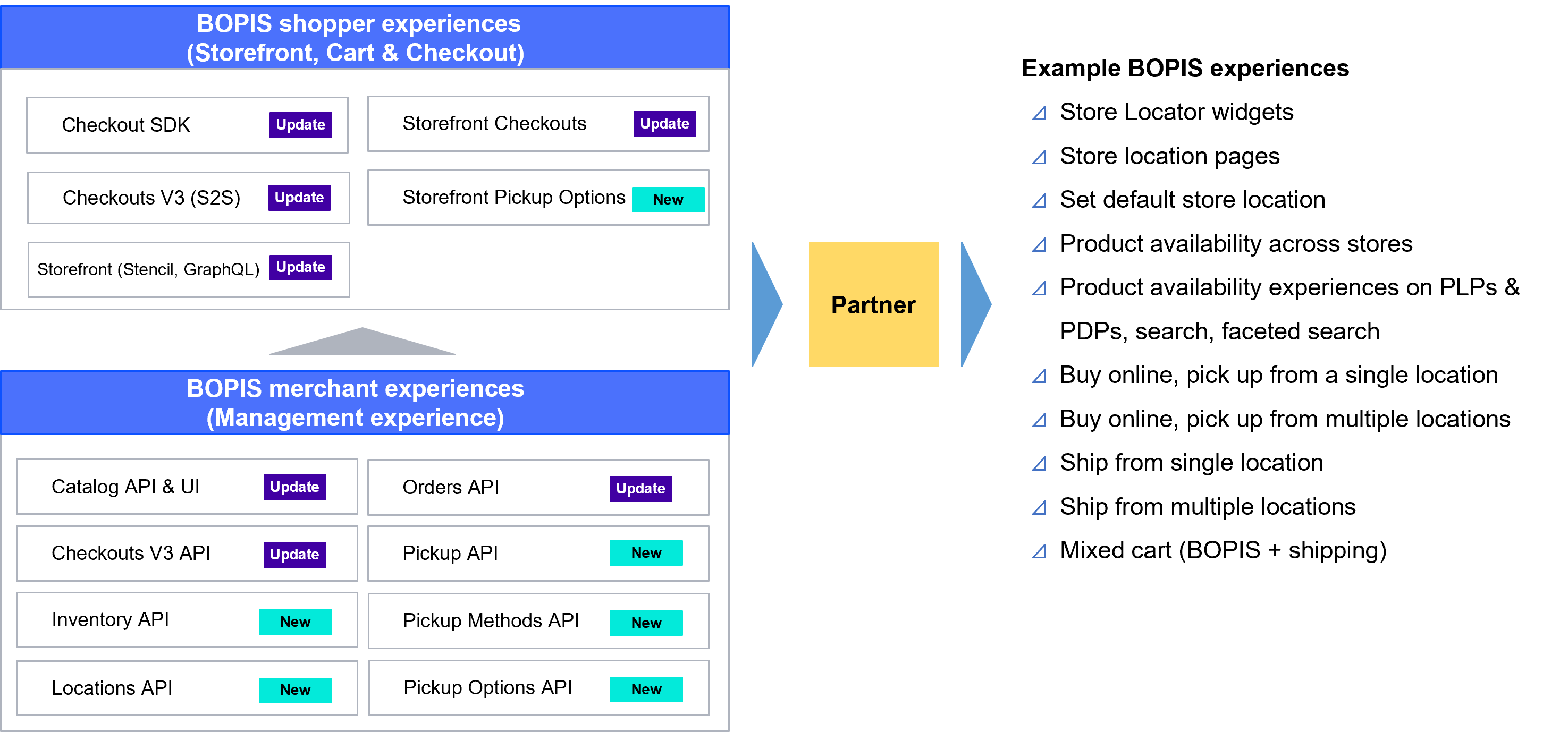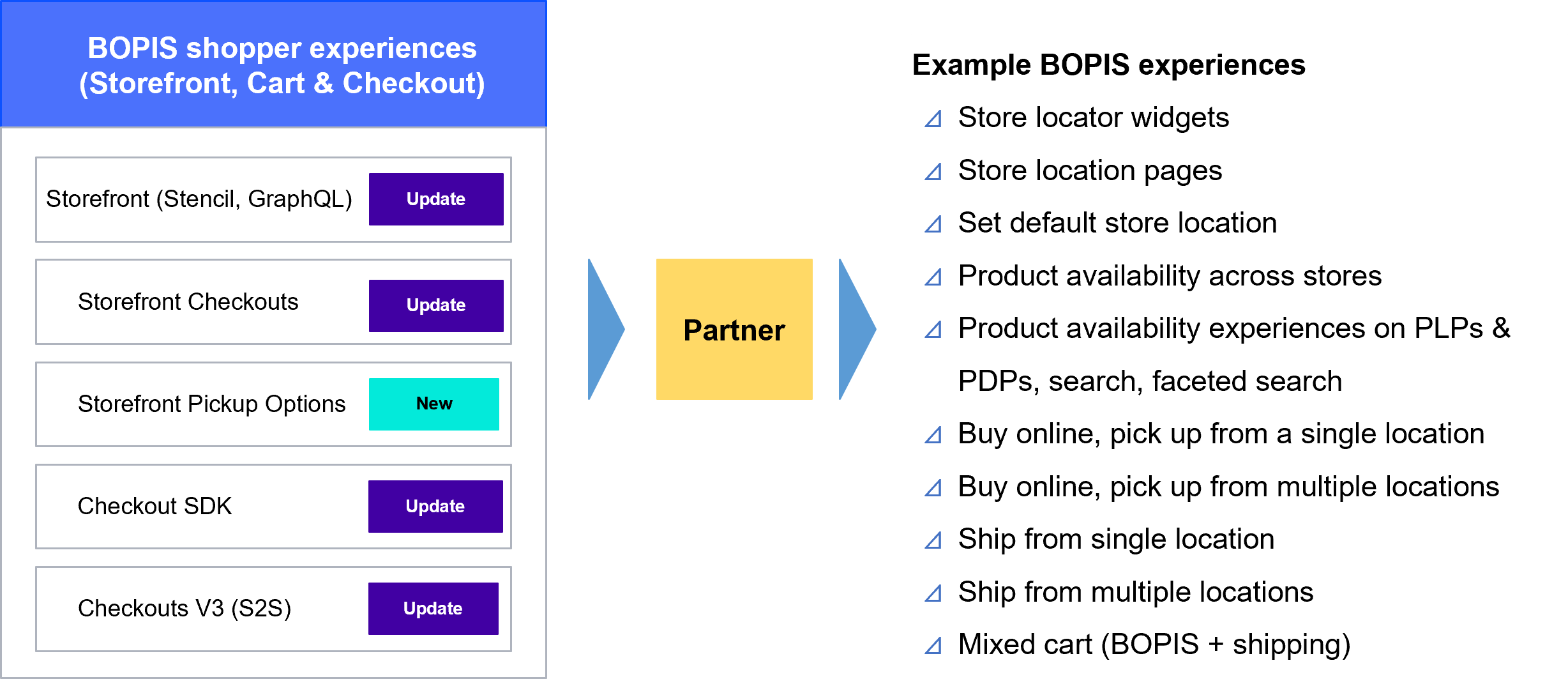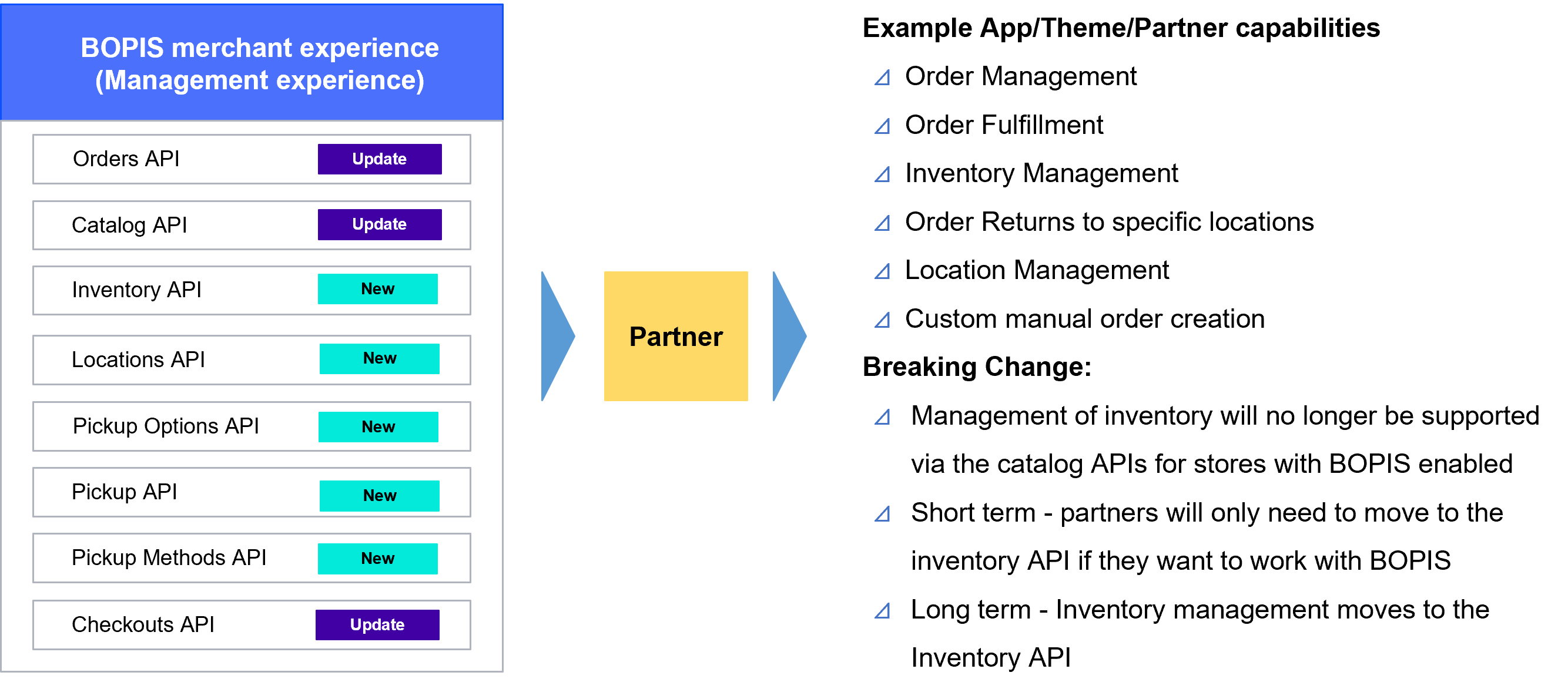Overview
Buy Online, Pick up in Store involves the following users:
- The shopper, who interacts with the storefront, cart, and checkout
- The merchant, who manages back office operations, such as locations, inventory, pickup methods, catalog, and orders
- The agency partner, who implements the project integrations
- The technology partner, who integrates solutions for the merchant, such as ERPs, OMSes, IMSes, listing marketplaces, etc.
As a developer, there are many ways in which you interact with these users to build Buy Online, Pick Up in Store.
You can store back-office components, such as location and inventories, on partner solutions. These partner solutions then serve as the source of truth for your data.
You can expose back-office components on the storefront. This would enable partners to create Buy Online, Pick up in Store experiences. For example, partners can create store locator widgets for the shopper.
The following diagram illustrates how all the different parts relate with each other.

The above diagram contains two colored symbols:
- Purple - Existing API endpoint, updated to support Buy Online, Pick up in Store.
- Aqua - New API endpoint, introduced to support Buy Online, Pick up in Store.
For more on the tools you can use to do build Buy Online, Pick up in Store experiences, see Shopper experience and Merchant experience.
Shopper experience
Shoppers are the end-customers who make a purchase on the retailer, or merchant, site.
The following diagram shows the API endpoints that support a Buy Online, Pick up in Store solution for shoppers.

To build custom experiences for shoppers, use the following tools:
GraphQL Storefront API
You can use the GraphQL Storefront API to query locations and inventory exposed to the storefront.
For more information, see Get Locations and Get Inventory.
If you want to customize a storefront theme, use Stencil Handlebars.
- BOPIS does not include new Stencil Handlebars.
- However, you can use GraphQL to define your own resources within the theme. You can add data such as inventory and locations the Stencil page context.
- For more, see GraphQL attributes under the Stencil Docs.
Storefront Checkout API
You can use the Storefront Checkout API to manage checkout operations on Stencil-powered storefronts.
- The API's consignment model now includes a pickup fulfillment type in addition to the existing shipping fulfillment type.
- The Checkout SDK uses the Storefront Checkouts API. Any updates made to the Storefront Checkouts API will also be reflected in the SDK.
Storefront Pickup Options API
You can use the Storefront Pickup Options API to allow shoppers to search for available pickup options near provided coordinates. Shoppers can retrieve pickup options for items based on shopper location and the availability of items at specific locations.
Merchant experience
Merchants are retailers who have BigCommerce stores and want to sell online.
The following diagram shows the API endpoints that support a Buy Online, Pick up in Store solution for merchants.

The following APIs are primarily targeted towards Mid-Market and Enterprise merchants who have in-house IT teams or work with agency partners to connect BigCommerce to external partner systems (e.g. ERP, OMS, IMS).
Inventory API
The Inventory API exposes location-aware, item-level inventory data. You can create BigCommerce apps and custom API-driven solutions that do the following:
- Track inventory across multiple locations.
- Display location-level inventory to shoppers.
- Provide multi-location fulfillment options.
- Facilitate Buy Online, Pick up in Store processes.
- Manage post-checkout order fulfillment.
For more information, see Inventory Overview.
Catalog API
When your store starts using the new Inventory API, you may experience breaking changes.
The Catalog API only supports basic inventory concepts (inventory_level, inventory_warning_level, inventory_tracking).
When you start using the Inventory API, inventory management not be handled through the Catalog API, but instead through the Inventory API.
Locations API
You can create new locations for your inventory using the Locations API For more information, see Locations Overview.
Pickup Methods API
You can use the Pickup Methods API to create pickup methods for your shoppers. The API lets you make the methods available at certain locations. These methods determine the options that are available to shoppers if they pick up their orders, i.e. fulfill their order with a pickup method.
Pickup Options V3 API
You can use the Pickup Options V3 API to retrieve pickup options for items. The retrieved options are based on the shopper's location and the availability of items at locations. The Pickup Options V3 API returns only options from locations in which all requested items are available.
Pickup API
"Pickup in store" is a new fulfillment method that supports Buy Online, Pick up in Store. You can use the Pickup API to manage pickups, including the items to be collected and the method of pickup.
Checkouts V3
You can use the Checkout V3 API to manage checkouts from server-to-server.
- The API's consignment model now includes a pickup fulfillment type in addition to the existing shipping fulfillment type.
- The pickup-in-store fulfillment type functions the same way as the Storefront Checkouts API.
Orders V2 API
To support Buy Online, Pick up in Store, the Orders V2 API uses consignments, or collections of line items and a fulfillment method. You can create orders that have a pickup, shipping, or digital fulfillment method for consignments. An order can have only one type of fulfillment method. Also, you can create only one pickup consignment per order.
The updates to the existing Orders V2 API were additive changes to ensure backward Compatibility.
Out of scope
Checkout routing logic API
- Such an API allows routing logic within an ERP/OMS to be exposed in the BigCommerce Checkout, to drive routing logic & thus shipping quote generation in the Checkout.
- This is out of scope because:
- It complicates the checkout which can negatively impact conversion.
- Shipping costs can decrease conversion. It's simpler to offer flat-rate shipping or free shipping to customers and provides a cleaner shopper experience.
- The merchant may already use a shipping partner who handles this complexity.
Mixed consignment orders
- Mixed consignment orders are made up of different types of consignments; a subset of products in a mixed consignment order may be pickup, while another subset of products in the order may be delivered.
- You cannot create mixed consignment orders. You can only create orders that have either pickup or shipping consignments, but not both.
Multiple pickup consignment orders
- A multiple pickup consignment order is one in which a subset of products in the order is picked up from one location, and another subset of products in the order is picked up from an entirely different location.
- For each order, you can only create one consignment with a single pickup location. You cannot create partial pickups.
- Multiple destination shipping addresses will still be supported.
Multiple shipping origins
Buy Online, Pick up in Store currently focuses on pick up in store capability that uses APIs. You currently cannot quote shipping rates from multiple shipping origins with partners.
Multi-channel awareness
Buy Online, Pick up in Store currently supports pick up on a single storefront channel. Currently, you cannot have different warehouse locations and inventory service different storefront channels.
In-stock transfers
Buy Online, Pick up in Store does not support in-stock transfers. Use a partner system (e.g. OMS / ERP), which is the source of truth for inventory and order management, to handle in-stock transfers.